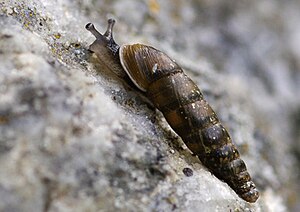Simplon door snail
| Simplon door snail | ||||||||||||
|---|---|---|---|---|---|---|---|---|---|---|---|---|

Simplon door snail ( Charpentieria dyodon ) |
||||||||||||
| Systematics | ||||||||||||
|
||||||||||||
| Scientific name | ||||||||||||
| Charpentieria dyodon | ||||||||||||
| Studer , 1820 |
The Simplon-door snail ( Charpentieria dyodon ) is a snail from the family door snails . The species is interpreted as a relic endemic to areas that remained ice-free even during the ice ages.
features
The case is spindle-shaped and left-handed. It has about 9 turns and measures 10–13 × 2.6–3 mm. The mouth has folds and lamellas as well as the closure plate (clausilium) typical of door snails. The animal can completely withdraw into the shell.
Geographical occurrence, habitat and way of life
The Simplon door snail was previously only found on the Simplon Pass in Valais (Switzerland) at an altitude between 880 and 1120 m above sea level. M. found. If, on the other hand, the extended range of species is accepted (see under synonymy and nomenclature), the species can also be found in Piedmont (Italy), near the southern slope of Monte Bo di Valsesia , in the Séssera Valley, in the Dora Riparia valley and near Nietro (west of Biella ) as well as in the canton of Ticino in the area of Lake Maggiore (Switzerland). The species lives on steep to vertical rocks in humid habitats at 850 to about 1150 m. In bad weather it lives hidden in rock crevices or mosses.
Synonymy and nomenclature
The species was first scientifically described by Samuel Emanuel Studer in 1820 under the name Glischrus (Clausilia) dyodon . The species appears very often with the misspelling diodon in the literature. Some authors see the following species as younger synonyms of C. dyodon : "Clausilia" Thomasiana (Küster, 1850) and Clausilia (Pedemontiana) Baudii Pini, 1885. This is important because this interpretation of the species range increases the geographical distribution area significantly. The website "Molluscs of Central Europe" considers Charpentieria dyodon and Charpentieria thomasiana to be specifically different, while the fauna treats Europaea thomasiana as a subspecies of Charpentieria dyodon . "AnimalBase, however, considers the two" species "to be synonyms. In addition to thomasiana , other authors put further subspecies of the species C. dyodon (Studer):
- Charpentieria dyodon paulucciana (Pollonera, 1885)
- Charpentieria dyodon emeria (Bourguignat, 1877)
- Charpentieria dyodon alpina (Stabile 1859)
- Charpentieria dyodon studeri (Pini 1884)
- Charpentieria dyodon thomasiana (sexton, 1850)
which would increase the range of species and the geographic distribution even further.
Danger
The species is on the Swiss Red List. It is classified there as "CR" (= critically endangered), corresponding to the status "threatened with extinction" in Germany.
swell
Individual evidence
- ↑ Markus Baggenstos: Surveys on the distribution and biology of the Nidwalden hair snail (Trochulus biconicus) as a basis for the formulation of protective measures. PDF ( page no longer available , search in web archives ) Info: The link was automatically marked as defective. Please check the link according to the instructions and then remove this notice.
- ↑ a b Francisco Welter Schultes in AnimalBase
- ^ Molluscs of Central Europe
- ↑ a b Fauna Europaea
literature
- Hans Turner: Atlas of the mollusks of Switzerland and Liechtenstein. Fauna helvetica 2 . 527 p., Neuchâtel (Switzerland): Center suisse de cartographie de la faune & Swiss Entomological Society 1998 ISBN 2-88414-013-1
Web links
- AnimalBase (here C. thomasiana (Küster, 1850) is considered a younger synonym of C. dyodon (Studer, 1820))
- Fauna Europaea (taxonomy)
- Molluscs of Central Europe